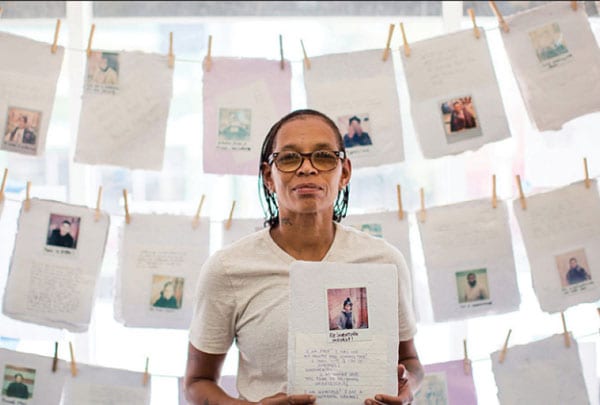
October 10, 2018; Next City
A new report issued by the Urban Institute is based on four in-depth case studies and an overall analysis of ways in which art is being used “to change the emotional experience within public safety and criminal justice spaces,” as reported by Emily Nonko for Next City.
The report, titled “Creative Placemaking and Community Safety: Synthesizing Cross-Cutting Themes,” explores what happens when techniques for creative placemaking are used with marginalized populations. It highlights how these techniques can “build community safety by promoting empathy and understanding, influencing law and policy, providing career opportunities, supporting well-being, and advancing the quality of place.”
The project highlighted in the Next City article, identified as “Art beyond Bars” in the Urban Institute report, is led by The People’s Paper Co-op, an ongoing initiative of The Village of Arts and Humanities in Philadelphia. Working with two legal-aid nonprofits—Philadelphia Lawyers for Social Equity and Community Legal Services of Philadelphia—artist-activists from The People’s Paper Co-op engage individuals who attend free expungement clinics seeking help to clean up their criminal records. Each client prints out their existing criminal record, tears it up and tosses it into a blender. From these “pulped” pages, new handmade paper is created. The client is then invited to respond to this writing prompt: “Without these records I am…” The responses are embedded into the new paper, along with a Polaroid photo of each client called a “reverse mugshot.”
Sign up for our free newsletters
Subscribe to NPQ's newsletters to have our top stories delivered directly to your inbox.
By signing up, you agree to our privacy policy and terms of use, and to receive messages from NPQ and our partners.
As explained by Seth Lyons, an attorney with Community Legal Services, adding this artmaking to the clinic experience has been transformative. He notes, “The clinic model is creating the most efficient way to see as many clients as possible, in a short amount of time, with little resources. It’s a legal process that can ignore the significance of what’s happening for that person.” But now, the symbolic act of shredding the old records and presenting each client with a literal blank slate “creates a space to see the power of this record, this piece of paper that holds people back but doesn’t have to define who they are.” He also notes that the artmaking helps “break down power structures,” and has fostered better collaboration among lawyers, law students, clients, and artists in the expungement clinics.
In addition to this project, the Urban Institute report includes three other case studies, described on the website (and detailed in the report) as follows:
- A Pathway to Connect Communities: A Case Study of the Beerline Trail Extension in Milwaukee, Wisconsin…is an effort to use creative placemaking techniques to turn an unused rail corridor into an active, safe, and inclusive space for local residents; bridge the gap between disparate communities; improve public safety; and promote inclusive economic development.
- Building beyond Policing: A Case Study of Eden Night Live in Alameda County, California…was a community festival and pop-up marketplace organized by the Alameda County Sheriff’s Office, designed to creatively reimagine and rebuild community-police relations. The study examines its effects on building local commerce, fostering community cohesion, and changing perceptions of public safety.
- Empowering Young People to Make Their Place: A Case Study of the Marcus Garvey Youth Clubhouse in Brownsville, Brooklyn…involves a developer, nonprofit organizations, and young people working together to design and build a programmed community space to revitalize and reimagine community safety in a high-crime, low-income neighborhood.
In Philadelphia, the words and photographs of participants in the expungement clinics that are embedded into the handmade paper have been sewn together to form a giant paper quilt, which has been exhibited across the city “in museums, galleries, city hall, church basements, legal clinics, city streets, detention centers and more.” Mark Strandquist, co-director of The People’s Paper Co-op, had this to say about the project: “Art allows us to trespass into spaces that have strategically and systematically silenced and excluded the voices of those impacted by the criminal justice system. It provides counter-narratives of people’s lives, dreams and potential.”—Eileen Cunniffe













